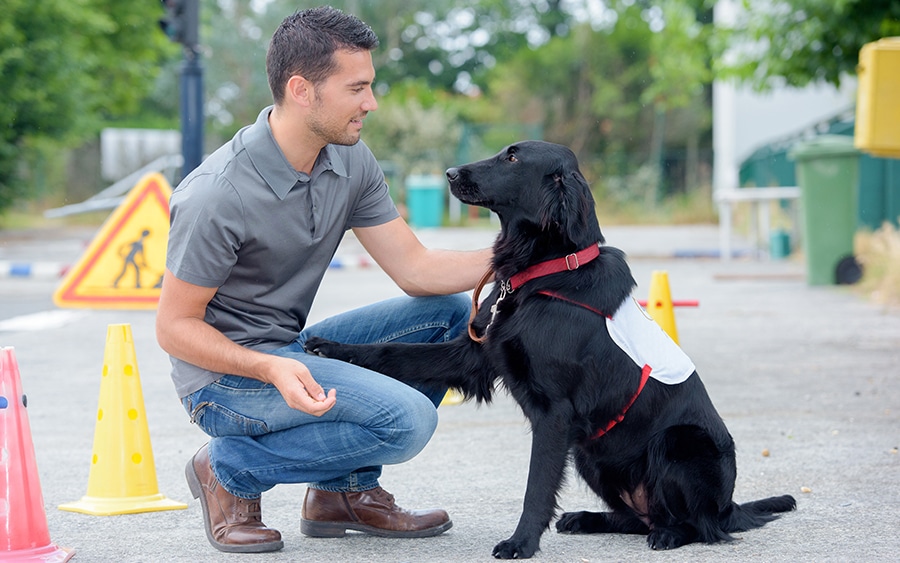Unleash Potential with Dog Training Near Me: Discover Your Local Experts
The Ultimate Overview to Canine Training: Building a Happy, Obedient Family Pet
Effective pet dog training is a complex procedure that hinges on a deep understanding of canine habits and the application of tested strategies. By welcoming positive support and consistent command use, pet owners can cultivate not only obedience yet likewise a strong, trusting connection with their dogs. The trip does not end with basic commands; attending to behavior issues and developing a supporting training atmosphere are equally vital parts. As we discover these elements, it becomes noticeable that the course to a content and mannerly canine companion may hold more complexities than one may initially presume.

Comprehending Dog Behavior
Just how does a pet dog's behavior reflect its psychological and emotional state? A pet dog's activities can offer as a window right into its sensations, needs, and general emotional well-being. A wagging tail generally indicates happiness and exhilaration, while a reduced tail might suggest anxiety or submission. Vocalizations such as yawping or barking can interact a variety of emotions, from happiness to distress.
Body movement likewise plays a critical duty in understanding canine actions. A kicked back posture and open mouth signal comfort, whereas strained muscles and pinned ears may recommend anxiety or hostility. Observing these signals is crucial for recognizing the origin causes of a pet's actions, whether it originates from excitement, disappointment, or concern.
In addition, a pet's interaction with its atmosphere and other pets can offer insight right into its psychological state. A canine that involves happily with other pet dogs is likely sensation social and safe and secure, while one that shows avoidance or aggressiveness may be experiencing stress and anxiety or insecurity. Understanding these behavior hints is vital for fostering a strong partnership between the pet dog and the proprietor, inevitably adding to the pet dog's psychological health and wellness.
Crucial Training Techniques
Efficient canine training strategies are essential for fostering desirable behaviors and strengthening the bond in between a pet dog and its owner. Making use of positive support is just one of the most efficient techniques, where incentives such as deals with, appreciation, or play are provided to reinforce desired behaviors (Dog training). This encourages the dog to repeat those behaviors, developing a positive discovering setting
Uniformity is another essential aspect in pet training. Commands should be uniform and clear, and all family participants must use the exact same guidelines to stay clear of confusing the pet dog. Timing is just as important; benefits need to be given quickly after the wanted habits to establish a clear link between the benefit and the action.
Additionally, appealing and short training sessions work, as pets have differing focus spans. Objective for sessions of 5 to 15 mins, depending upon the pet dog's age and power level. Integrating play into training can also enhance inspiration and satisfaction for both the pet dog and the owner.
Finally, patience is important. Dogs discover at their own speed, why not try here and preserving a calm disposition will certainly help ease stress, making certain a favorable training experience. These crucial methods lay the groundwork for successful dog training and an unified relationship.
Standard Commands to Educate

Usage deals with, praise, and play to reward your dog's successes. By instilling these standard commands, owners equip their pets with the abilities necessary for a harmonious and mannerly partnership.
Addressing Typical Behavioral Concerns
Comprehending and addressing usual behavioral concerns in dogs is necessary for promoting a harmonious connection in between animals and their owners. Lots of pet dogs show habits such as excessive barking, eating, or hostility, which can come from stress and anxiety, boredom, or lack of appropriate training. Determining the root reason of these actions is the initial step toward reliable treatment.
As an example, too much barking may indicate a demand for interest or a reaction to ecological stimuli. In such instances, owners ought to assess the pet dog's environment and offer sufficient psychological excitement, such as interactive toys or routine exercise. Chewing can typically be taken care of by rerouting the actions to proper eat things and guaranteeing that the pet has adequate physical activity to minimize dullness.
Hostile habits calls for mindful handling and might require specialist training help. It's crucial to comprehend that punishment can exacerbate anxiety and hostility, bring about a cycle of behavior issues. Rather, concentrate on favorable support methods to award desirable actions and enhance a complacency.
Building a Positive Training Environment
Producing a favorable training setting is essential for reinforcing desirable habits in dogs and alleviating behavior problems. This atmosphere should be characterized by consistency, motivation, and a clear understanding of the training goals. By establishing a regular, pets discover what is anticipated of them, which assists reduce anxiousness and confusion.
Using positive support techniques, such as treats, appreciation, and play, fosters a sense of protection and motivation in the pet dog. Rewarding great behavior instantly and regularly enhances the preferred activities, making the training procedure a lot more effective - dog training charlotte nc. Furthermore, trainers need to stay client and tranquility, as pets are delicate to their handlers' emotions
The training room need to page be devoid of disturbances to make certain the canine can concentrate on the jobs handy. Take into consideration making use of a quiet space or a safe and secure exterior area. Additionally, integrating play and socialization right into training sessions advertises a well-rounded approach, enhancing the pet dog's knowing experience.
Eventually, a positive training environment nurtures a strong bond in between the pet and trainer, leading to a loyal, pleased pet dog. By prioritizing this atmosphere, pet proprietors can properly attend to behavior difficulties and cultivate an effective training journey.
Conclusion
Efficient pet dog training depends on a detailed understanding of canine habits and the application of favorable support strategies. By mastering necessary commands and attending to behavior issues with perseverance and clear communication, proprietors can promote a solid bond with their pets. Producing a helpful training atmosphere boosts safety and count on, ultimately causing the growth of a joyous and mannerly buddy. Taking on these concepts makes certain a rewarding training experience for both pets and their owners.
Reliable canine training is a multifaceted process that hinges on a deep understanding of canine habits and the application of tried and tested strategies. A canine that involves happily with other canines is most likely feeling social and safe and secure, while one that shows avoidance or hostility might be experiencing stress and anxiety or insecurity.Effective dog training methods are essential for fostering desirable habits and strengthening the bond between a canine and its owner.Producing a favorable training environment is essential for reinforcing desirable behaviors in dogs and minimizing behavior issues.Efficient canine training counts on a comprehensive understanding of canine behavior and the application of favorable support strategies.